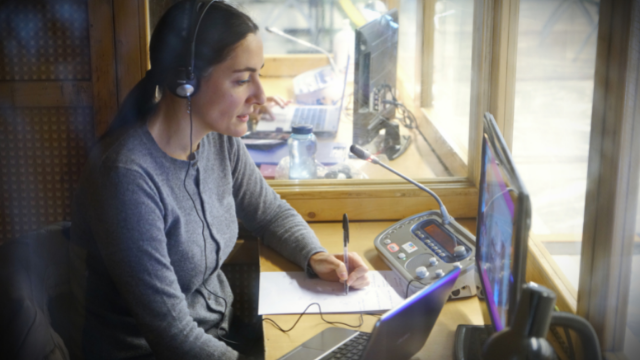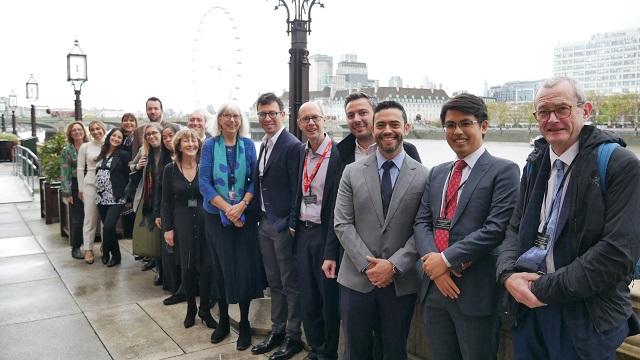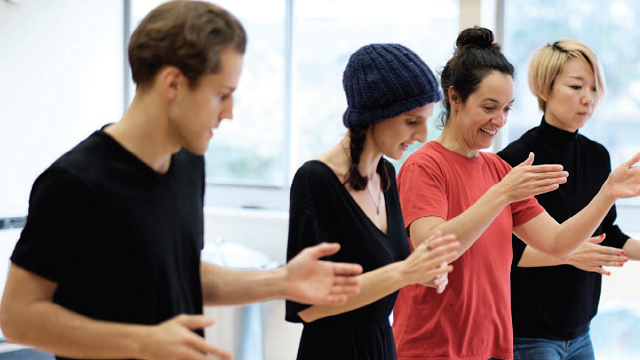-
QUALIFICATIONS
- For Linguists Worldwide
- For UK Public Services
- Preparation
- Policies & Regulation
-
MEMBERSHIP
- Join CIOL
- Membership grades
- NEW for Language Lovers
- Chartered Linguist
- Already a member?
- Professional conduct
- Business & Corporate Partners
-
ASSESSMENTS
- For Second Language Speakers
- English as a Second Language
-
TRAINING & EVENTS
- CPD, Webinars & Training
- Events & Networks
- CIOL Mentoring
-
NEWS & VOICES
- News & Voices
- CIOL eNews
- CIOL Awards
- The Linguist
- Jobs & Ads
-
RESOURCES
- For Translators & Interpreters
- For Universities & Students
- Standards & Norms
- CIOL & AI
- APPG
- In the UK
- UK Public Services
- Find-a-Linguist
Interpreting: From C to B
by Sophie Llewellyn Smith*
 Sophie Llewellyn Smith offers her advice on self-assessing a C language, and effective approaches to turning it into a B language
Sophie Llewellyn Smith offers her advice on self-assessing a C language, and effective approaches to turning it into a B language
An interpreter’s quest for rock solid passive languages is never-ending. How can you assess the lacunae in your passive or ‘C’ languages and design an action plan to address your weaknesses?
Resources for foreign language learners are designed for linguists in general, rather than for interpreters in particular, meaning courses to help you learn a foreign language will only get you so far. Once you’ve acquired the basics of a language you will have to create your own programme to meet your goals. Here’s one way to go about it:
Analyse what you need to know. Think about the kind of interpreting you do, or want to do: Medical? Legal? Conference? What are the benchmarks for qualification, and what range of vocabulary is involved? Whereas an in-house interpreter for a car manufacturer may be exposed to a limited vocabulary and uniform meeting types, a conference interpreter working for the EU institutions would need to meet accreditation standards and be able to cope with a wide range of terminology, registers and speaking styles.
Check your knowledge. Based on your response to step 1, find source materials that will test you in relevant areas: fast, dense material; idiomatic or technical material; formal or colloquial material. Where are the gaps in your knowledge: Terminology? Cultural references? Idiomatic expressions? What happens when you encounter challenges – does your output suffer? Is your delivery marred by false starts, hesitations or fillers?
Work on coping strategies. This relates particularly to where unknown or difficult words cause problems with your technique. Depending on the issue, you may need to focus on stress management strategies, generalising and/or summarising, or adapting decalage (i.e. the time between the start of the speech and the start of the interpretation). Cloze exercises (where you input words missing from a text) and sight translation are helpful for developing workarounds.
Fill the gaps in your knowledge. This can be done in various ways, but I have offered a few tips to point you in the right direction below (see ‘Improving your C language’).
Gaining fluency
For many interpreters, adding another C language is of less value than turning a C language into a B, because they work in markets where it pays (or is essential) to be biactive. AIIC’s definition of a B language is “a language in which the interpreter is perfectly fluent, but which is not a mother tongue”. I’m ambivalent about this definition, because the word ‘perfect’ isn’t defined and surely implies ‘native’ fluency. This conflates the ability to do a retour (i.e. interpret into a non-native B language) with native or near-native ability in the B language.
Many interpreters with noticeable non-native features in their B language provide an excellent service, without their clients feeling that they are lacking in any way. (The bar is set higher or lower depending on the employer and the type of interpreting involved.)
To my mind, interpreting successfully in a B language means expressing the speaker’s intentions faithfully and clearly, even with a reduced ‘toolkit’, and this requires strong problem-solving skills. The interpreter must be able to work around obstacles, thanks to anticipation, reformulation, ‘chunking’, strategic use of intonation, and a supply of ready-made solutions for particular linguistic and cultural challenges.
Viewing retour skills through the lens of problem-solving abilities moves the goalposts; it allows you to approach the work of turning a C language into a B, not with a view to learning a language ‘perfectly’, but with the aim of boosting a set of definable skills. Instead of retourists feeling that they fall short compared to native speakers when interpreting into their B language, they can view this work as a set of challenges which their problem-solving skills will help them overcome, with the aim of shaping a retour that is fit for purpose.
A focus on problem-solving
How, then, to develop these problem-solving skills? Just as you won’t become a fantastic hairdresser if all you do is look at pictures of great haircuts, if you want to improve your retour interpreting, you need to focus on the most useful activities and exercises to improve the relevant sub-skills.
Two of the most common mistakes I see aspiring retourists make are 1) doing nothing but interpret speeches during their practice time, and 2) trying to improve their B language with methods that are too passive (and more suited to improving a C language). For example, they spend a lot of time watching TV, reading articles or listening to the radio while having breakfast or washing up. I’m not suggesting these activities are pointless. However, they conflict with what I see as one of the cardinal principles of retour work: if you can’t talk spontaneously and idiomatically in your B language, how can you hope to interpret successfully?
Over the years, I have come across many interpreting students and coaching clients who don’t like preparing speeches, doing role plays or improvising in their B language. But focusing exclusively on interpreting into your B language, because you are uncomfortable just speaking it, is like trying to run before you can walk. Working towards a strong retour involves first improving your speaking skills (syntax, pronunciation, vocabulary and intonation), then building in some set phrases for particular situations, and then practising interpreting.
To improve your speaking skills, you need to move away from passive, listening-based exercises, and replace them with active exercises where you have to say something out loud. This will help you to work on one or more of the important sub-skills mentioned above. Instead of passively listening to a podcast try shadowing (i.e. simultaneously repeating what you hear, B>B, in order to work on accent or intonation). When reading a newspaper article, read it out loud; select key nouns and verbs, and look for alternatives. If the subject of the article interests you, prepare a short speech on the topic and deliver it out loud (to the mirror if necessary). Follow up by choosing an article in your A language and sight translating it into your B language.
When listening to the news in your B language try giving a one-sentence summary of each news item. While reading literature, note down three interesting phrases and incorporate them into the next speech you prepare. Don’t stop at revising a point of grammar – also invent five example sentences with the target structure.
If you’ve picked up some useful turns of phrase from press articles or radio programmes, make a point of activating them rather than letting them stagnate as part of your passive vocabulary. For example, you could pick a topic for a conversation class with a native speaker and incorporate five new phrases into your chat, or do a few role plays on a relevant topic with a practice partner. You could even do some B>B consecutive or (harder!) simultaneous interpreting on a suitable topic, and reformulate the source material, incorporating your new phrases. For a break from formal learning, have fun and work both on the flexibility of your B language and on your delivery. Ideal candidates for this are games like Articulate, Taboo and Just a Minute.
Spending time on improving your speaking skills alongside your retour interpreting skills pays off in more ways than one. It enriches your vocabulary, gives you ready-made solutions to draw on under pressure, teaches you to overcome linguistic and interpreting challenges, boosts your confidence, reduces the need for a native speaker to correct your mistakes, and helps you sound more natural.
Whether you’re working on improving a C language or turning it into a B language, I hope to have persuaded you that practising interpreting is not the be-all and end-all. Active exercises are the key to producing C or B languages that are evaluated not based on some unrealistic standard of perfection, but on whether or not they are fit for purpose.
*You can also find Sophie at our 2022 conference. Click the image below to book:
Improving your C language
Once you’ve assessed the gaps in your knowledge and vocabulary, there are many ways to work on improving your abilities:
1 Think carefully about how much time you have to devote to your C language, and what your learning style is. Do you prefer reading or listening? Are you a visual learner? We all lead busy lives, and if you’re combining language studying with a job and/or family life, it’s best to look for activities that you enjoy and fit into little pockets of time in your day.
2 Be consistent. Language knowledge is one of those ‘use it or lose it’ activities, so aim for little and often.
3 Make use of new technologies and the internet. Back in the day, I would write a list of new vocabulary I had encountered in the papers, record the words on cassette (ha!), leave a blank, and then give the translation. Nowadays, you can use your mobile phone to do much the same thing, or explore apps such as Quizlet to create flashcards and audio recordings.
There are tech solutions for everything from acquiring basic vocabulary and listening to native speakers in context (e.g. FluentU) to finding practice material (e.g. SCIC Speech Repository and TEDx talks) to checking your understanding after interpreting a speech (e.g. by switching on the captions on a YouTube video). These options can add fun and variety to your practice, and save time.
4 Listen actively. Don’t just try to absorb by osmosis. Useful tasks to set yourself when listening to C-language materials include giving a brief oral summary of what you’ve heard; writing three questions about it and listening back to find the answers; and discussing what you’ve heard with someone else.
5 Change the balance as your knowledge becomes more advanced. You can’t understand the structure of a language without some book learning about conjugations, declensions, phonology and so forth. A typical example of this is the differing use of verb tenses between languages, which can affect the meaning of a sentence. As your knowledge advances, however, it’s important to shift the focus from grammar and word lists to understanding the language in context.
Interpreting from a C language is very rarely an exercise in information retrieval akin to a listening comprehension. It’s not about words; it’s about understanding a speaker’s intentions, ideas and tone. Often, this comes packaged in humour, cultural references and idioms. This is where you need to move beyond textbooks and into the real world; depending on your weaknesses and needs, you might like to watch TV, listen to political satire or read children’s books, school textbooks or lifestyle magazines.
6 Last but not least, practise interpreting the type of material you will be exposed to at work. It’s a good idea to record your performances. Leave a gap of a few weeks or months, try again and compare the two versions in order to assess your progress.
More
The Chartered Institute of Linguists (CIOL), Incorporated by Royal Charter, Registered in England and Wales Number RC 000808 and the IoL Educational Trust (IoLET), trading as CIOL Qualifications, Company limited by Guarantee, Registered in England and Wales Number 04297497 and Registered Charity Number 1090263.









